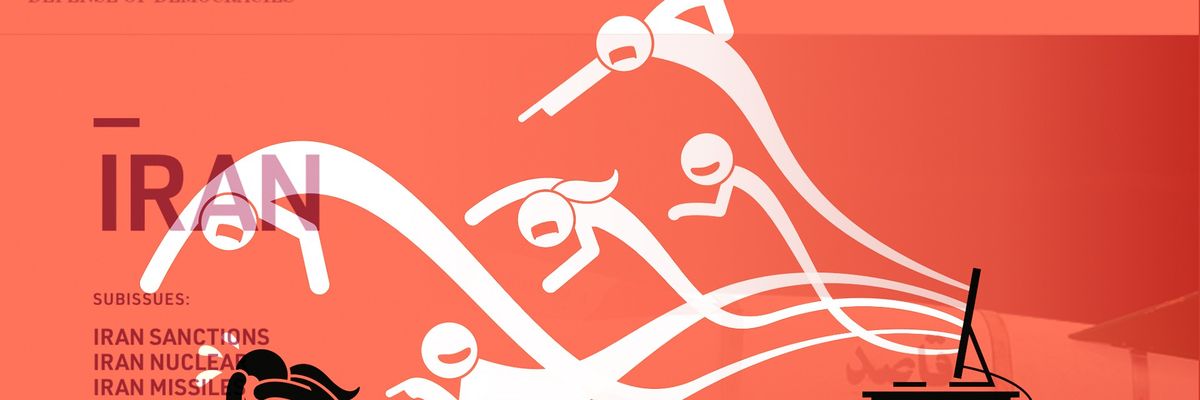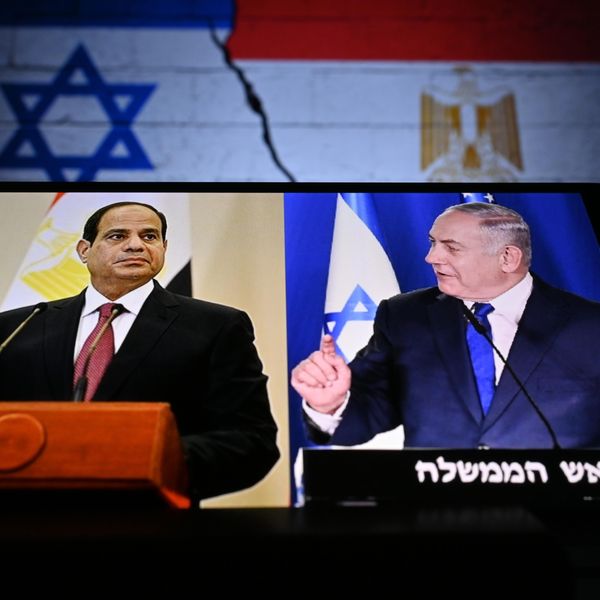This article was co-published with The American Conservative.
The Foundation for Defense of Democracies, a think tank that has promoted U.S. military strikes on Iran and is funded by one of President Donald Trump’s biggest campaign megadonors, served as a messaging hub for a controversial taxpayer-funded project, the Iran Disinformation Project, that engaged in harassment of American critics of the Trump administration’s foreign policy in the Middle East.
Two congressional sources who attended a briefing with State Department officials from the Global Engagement Center confirmed that Saeed Ghasseminejad, an FDD senior adviser, was a contractor on the project, the second time within the past month that an FDD employee has been implicated in harassment campaigns against critics of the Trump administration.
Ghaesseminjad’s affiliation with FDD appears to have little to do with promoting democracy. He reportedly expressed admiration for Vladimir Lenin’s concept of “democratic centralism” and referred to Chilean dictator Augusto Pinochet as “the departed dear [leader] who saved Chile … and was much better than Salvador Allende,” the democratically elected Chilean Socialist President who was overthrown in a 1973 CIA-backed coup.
Documents acquired via a Freedom of Information Act lawsuit* with help from Protect Democracy details FDD staff scheduling multiple meetings with State Department officials to discuss “communications,” and an FDD executive introducing Ghasseminejad to officials at the State Department’s Iran Action Group that was created by Secretary of State Mike Pompeo to coordinate U.S. policy toward Iran following Washington’s withdrawal from the Joint Comprehensive Plan of Action, a nuclear accord with Iran brokered under the Barack Obama administration.
In May 2019, the State Department terminated the $1.5 million Iran Disinformation Project — which was purportedly intended to combat misinformation emanating from Iranian officials — in the wake of a scandal generated by the project’s attacks on domestic critics of the Trump administration’s policy. In one instance, the project’s Twitter account attacked a Human Rights Watch analyst who was researching the impact of U.S. sanctions on Iranians, claiming she was promoting “so-called Moderates” within Iran at the expense of documenting human rights violations. In another attack, the account accused a BBC journalist of being one of the “#IranDisInfo mouthpieces in @BBC.”
In several instances, FDD and Ghasseminejad’s own Twitter accounts joined in to amplify the Iran Disinformation Project’s harassment or were retweeted by the Iran Disinformation Project’s account.
Ghasseminejad’s tweet attacking Iranian American journalist Negar Mortazavi for covering her hair when meeting with Iran’s foreign minister, Javad Zarif, was retweeted by the State Department-funded project. Ghasseminejad, who later deleted the February 2019 tweet, wrote: “Negar Mortazavi attacked an Iranian journalist for meeting @SecPompeo. Not long time ago, @NegarMortazavi covered her hair to meet @JZarif, Iran’s Ribbentrop, who denies the existence of political prisoners & represents the radical Islamist terrorist regime of Iran.”
The project’s own Twitter account attacked the Atlantic Council, a mainstream Washington-based foreign policy think tank, and celebrated the organization’s decision to cancel an event with Zarif, referring to “[Zarif] and other leaders of the corrupt tyrannical regime of Iran,” in a February 2019 tweet.
In April 2019, the State Department-funded project and FDD attacked another U.S. foreign policy think tank, the New York-based Asia Society, retweeting a tweet by FDD senior fellow Alireza Nader accusing the Society of “allow[ing] [Zarif] to use them as a platform to spread disinformation and lies” in reference to an upcoming event with Zarif. Nader later deleted the tweet.
The project and FDD even launched ad hominem attacks on Washington Post and New York Times journalists.
In February 2019, the Iran Disinformation Project retweeted a tweet by Mariam Memarsadeghi, the co-founder and president of the E-Collaborative for Civic Education, a group that ran the same project for the State Department, in which she accused Washington Post reporter Jason Rezaian of “spreading regime disinfo” and the Post of “publishing (again) his regurgitated lies.” The same month, the project retweeted Nader accusing New York Times journalist Thomas Erdbrink, who was then the Times’s Tehran bureau chief, of “parrot[ing] regime propaganda.” “Why not pull him out [of Tehran]?” asked Nader, who later deleted the tweet.
The details of the Iran Disinformation Project’s termination were reported last month by The Intercept, which acquired the same FOIA documents. It reported the project was run through the ECCE, a group that received nearly $10 million in U.S. government contracts to operate a variety of Iran-related projects over the past decade.
But the role of FDD staff in the Iran Disinformation Project has remained unclear until now. Last June in the wake of the Iran Disinformation scandal, State Department officials held a closed-door briefing with congressional offices to discuss the project’s abuses.
"[State Department Global Engagement Center (GEC)] officials confirmed in our meeting that Saeed Ghasseminejad was a paid staffer for Iran Disinfo,” said a congressional staffer who requested anonymity. “The whole thing looked like a front for FDD and other regime-change hawks."
A second staffer who attended the June 2019 meeting with GEC officials said that Ghasseminejad was brought up at the briefing and that his role as a contractor was confirmed.
Ghasseminejad and FDD’s involvement with the Iran Disinformation Project was evident in June 2019 even while FDD and its staff sought to maintain official distance from the controversial project.
The Iran Disinformation Project website and Twitter account regularly promoted FDD CEO Mark Dubowitz and Ghasseminejad. FDD’s own website maintained an “Iran Disinformation Project” section that republished articles authored by Ghasseminejad for the State Department-funded project’s website. And on at least five occasions, FDD’s Twitter account promoted Ghasseminejad’s work for “@IranDisInfo” but directed readers to FDD’s website instead of the State Department-funded website.
Following the uproar over the Iran Disinformation Project’s activities and FDD’s apparent links to the project, Dubowitz denied his organization’s involvement, tweeting, “conspiracists” see “FDD’s hand in everything.” Ghasseminejad tweeted, “FDD is not involved in any way with the [Iran Disinformation Project],” but later deleted the tweet.
The confirmation by two congressional staffers of Ghasseminejad’s involvement and documents procured as part of the FOIA lawsuit paint a picture of an FDD staffer working as a contractor with the Iran Disinformation Project and FDD senior leadership actively aware of, and in at least one case facilitating, Ghasseminejad’s contact with the State Department.
A September 14, 2018 email shows Ghasseminejad scheduling a meeting with Kiarash Ehfad, a “Social Media Strategist” and consultant at the State Department, according to Ehfad’s LinkedIn profile. Ghasseminejad invited Toby Dershowitz, FDD’s Senior Vice President of Government Relations and Strategy, to join the meeting.
And an April 5, 2019 email from Dershowitz to a State Department official whose name was redacted from the text shows the FDD executive introducing Ghasseminejad as an “FDD Iran expert” and asking “if you might be available to meet him to discuss a variety of communications-related issues.”
The official appears to forward the email to another redacted address, writing, “Pls schedule. Len should join if he’s in or someone else from IAG,” presumably referring to Len Khodorovsky, then Senior Advisor for Public Affairs in the Iran Action Group.
In another internal document, Ghasseminejad is listed as a “prospective contractor/grantee” as part of the Iran Disinformation Project.
Ghasseminejad’s participation in the Iran Disinformation Project follows a pattern of FDD staff participating in targeted online harassment campaigns against critics of the Trump administration’s Middle East policies.
Last month, Marc Owen Jones, a professor based in Qatar, reported for Responsible Statecraft how FDD research fellow Benjamin Weinthal was harassing critics of the Trump administration- brokered UAE-Israel “peace deal.” Jones, who was critical of the deal, received approximately 90 tweets from Weinthal, making numerous defamatory accusations including, “you are a raging homophobe,” “Marc ostensibly supports the execution of gays in Qatar,” and “you are widely believed to be serving as a kind of foreign junior human resources department for Qatar’s homophobic regime.”
Twitter confirmed that Weinthal’s conduct on their platform was “violating our rules against hateful conduct.”
And last November, a Twitter account controlled by FDD’s Iran Program tweeted a baseless conspiracy theory about Rep. Ilhan Omar (D-Minn.), asserting that, “#IlhanOmar was recruited by a foreign government, received funding from a foreign government, and passed sensitive information through intermediaries to #Iran.” FDD later deleted the tweet.
FDD did not respond to a request for comment about their role in the Iran Disinformation Project or answer questions about their staff members’ use of social media to harass critics of the Trump administration’s foreign policy.
FDD’s refusal to rein in their staff’s more egregious behavior towards critics of the Trump administration’s abrogation of the JCPOA and “maximum pressure” sanctions campaign against Iran is consistent with sentiments expressed by one of the group’s biggest funders. Bernie Marcus, Home Depot’s co-founder and a Trump megadonor — contributing $7 million in 2016 to Trump’s election efforts — sits on FDD’s board and contributed $4.3 million to FDD in 2018, 35 percent of the organization’s annual revenue.
Marcus, much like Trump, Weinthal, and Ghasseminejad doesn’t hold back about his radical views on Gulf politics and is quick to engage in vitriolic language. When asked about the JCPOA during a 2015 Fox Business interview, Marcus shot back, “When you do business with the devil you’re in deep trouble and I think that Iran is the devil.”
*In the interest of full disclosure, Quincy Institute Executive Vice President Trita Parsi was a party to the lawsuit. He had no role in the reporting, drafting or editing of this article.
















